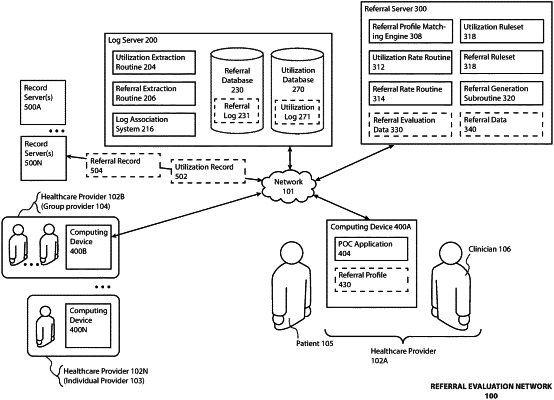| CPC G16H 15/00 (2018.01) [G16H 10/60 (2018.01); G16H 40/20 (2018.01); G16H 80/00 (2018.01)] | 20 Claims |

|
1. A method for structuring electronic data logs for efficient determination of a healthcare referral provider from a point-of-care application, the method comprising:
determining generation of a healthcare utilization record comprising a patient UID of a first patient and a provider UID of a first healthcare provider;
determining a place of service value that describes a type of facility associated with the healthcare utilization record;
determining a type of service associated with the healthcare utilization record;
generating a first utilization log comprising the provider UID of the first healthcare provider, the place of service value, a type of service value, and a utilization time associated with at least one of providing a healthcare service to the first patient and generation of the healthcare utilization record;
storing a utilization log in an electronic database storing a log data structure comprising: (i) a set of data each modeling healthcare providers associated by one or more referral logs, and (ii) a set of utilization logs each associated with a data from the set of data each modeling healthcare providers;
initiating a referral request on a user interface of a clinical documentation workflow of the point-of-care application running on a computing device of a second healthcare provider to refer a second patient of the second healthcare provider to a referral provider;
generating a referral profile for the second patient, the referral profile comprising a place of service range, a type of service range, and a time range,
extracting the set of utilization logs from a utilization database,
wherein the set of utilization logs comprises the first utilization log comprising the place of service value, and
wherein the set of utilization logs each comprise at least one of the place of service value and a different instance of the place of service value;
comparing the referral profile to the set of utilization logs;
generating a reduced dataset comprising a subset of utilization logs extracted from the set of utilization logs matching the referral profile,
wherein a number of healthcare providers associated with the reduced dataset is compared to a minimum threshold of healthcare providers to determine a sufficient number of healthcare providers within the reduced dataset;
calculating, using the subset of utilization logs in the reduced dataset, a POS utilization rate of the first healthcare provider for each instance of the place of service value within the place of service range,
wherein the POS utilization rate is a set of percentage values, each percentage value a number of utilization logs in the reduced dataset comprising an instance of the place of service value within the place of service range relative to a total number of utilization logs in the reduced dataset;
applying a utilization ruleset to at least one of score, rank, and qualify the first healthcare provider based on criteria comprising the POS utilization rate;
adding the provider UID of the first healthcare provider to a referral data; and
transmitting the referral data over a network from a server to the computing device of the second healthcare provider running the point-of-care application, where the referral data is integrated within the user interface of the clinical documentation workflow of the point-of-care application.
|